Does 5G Enable Smart Wireless Edge Technology? Artificial Intelligence And 5G Mutual Services
The Fifth Generation Of Communication Networks And Artificial Intelligence Are Among The Most Influential Technologies Of The Third Millennium That Will Change Our World Significantly.
While these technologies are revolutionary in their own right, and each has the potential to revolutionize a variety of industries and improve productivity and productivity, the combination of 5G and AI will be truly transformative.
Combining the two technologies leads us to a new technology called Intelligent Wireless Edge.
The intelligent wireless edge allows us to process on-device, cloud edge, and 5G together and have a stable, fast connection at any time and any place in all services and intelligent devices. To be more precise, we reach a new level of instantaneous intelligence that we have never experienced before.
In the new technology, large volumes of data are processed close to their source. This processing can be done on a device equipped with artificial intelligence connected to the edge cloud hosted on a 5G network with low latency.
Data processing on consumer devices equipped with artificial intelligence is crucial because it offers many benefits such as privacy, personalization, and reliability. Figure 1 shows the performance of this technology. Given the massive influx of 5G -enabled devices, it is expected that most intelligent applications will be able to deploy on the edge of wireless networks.
This process will lead companies to implement a “smart edge” concept and move from artificial intelligence.
Use on edge devices. Accordingly, in the future, we are expected to encounter a new concept called “edge learning,” which is an interdisciplinary science and is the product of the integration of 5G technologies and artificial intelligence.
The central theme in edge learning is overcoming the limited computational power and the limited data of edge devices. For this purpose, the Mobile Edge Computing Platform (MEC) and the extraction of data distributed by edge devices should be used.
In this architecture, two vital aspects are learning from distributed data and communicating between edge servers and devices. The intelligent wireless edge can use in connection with current services and in many new applications in the future, some of which have not even officially entered the tech world yet!
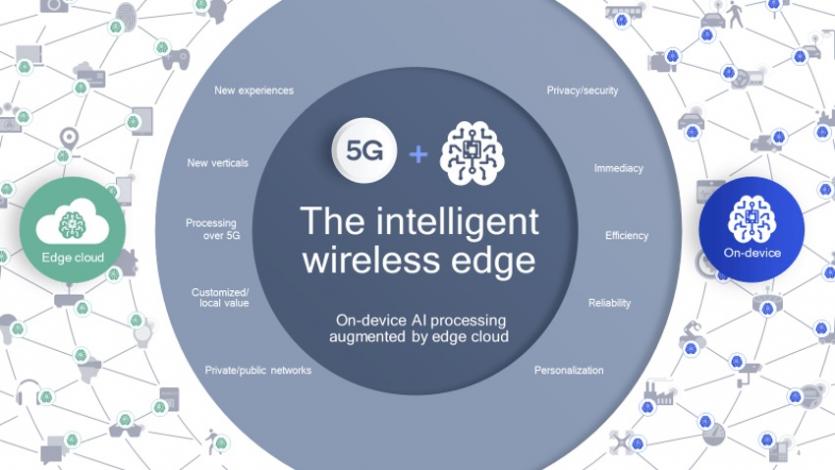
figure 1
Artificial intelligence improves 5G performance and devices that support the technology.
The use of artificial intelligence in 5G networks improves the performance of wireless communications, increases the battery life of devices, and provides a better user experience. Intelligent algorithms perform powerfully in most areas but achieve such performance in wireless networks. The focus is on the significant challenges surrounding wireless networks that are difficult and complex to overcome through conventional methods, so machine learning is the best option in this field.
We need in-depth knowledge of wireless amplitudes, spectra, and frequencies to identify where artificial intelligence can use.
Almost all leading technology and telecommunications companies like Qualcomm are looking to use artificial intelligence to improve the performance of 5G networks and somehow turn intelligent algorithms into an integral part of the hardware.
If this is achieved, AI will dramatically impact critical areas of 5G networks, such as more efficient management, improved service quality, easier deployment, improved network performance, and improved network security (Figure 2).
For example, artificial intelligence can use unique methods such as analyzing consumer behavior and detecting abnormalities in network traffic, such as saturation, impersonation, or abnormal spectrum use.
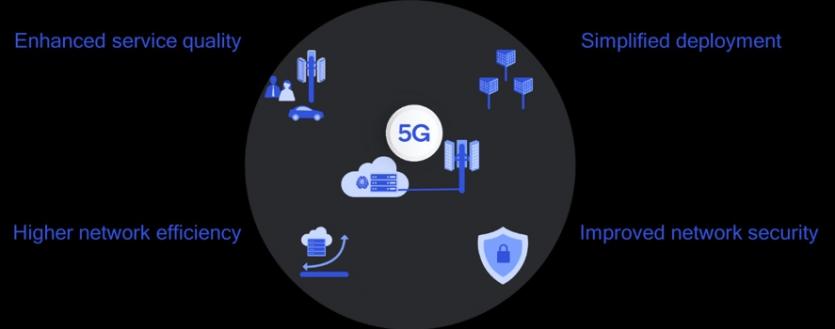
figure 2
A lesser-known topic is how artificial intelligence can improve the performance of 5G network endpoint systems. Typically, machine learning is the best way to understand the operation of complex RF signals around receivers or transmitters. The more we know about the radio waves emitted by 5G equipment under the heading of radio awareness
(Radio awareness) is called, we can more efficiently optimize 5G networks, increase the number of devices in a specific area to the 5G network, improve overall network performance and make network security more secure due to the complex arrangement of 5G networks (Figure 3).

Figure 3
5G allows you to make better use of artificial intelligence
Low latency and high 5G capacity allow artificial intelligence computations to be distributed between devices, edge cloud, and center cloud to achieve the highest computational flexibility. Wireless edge architecture is compatible and allows sending and receiving various computational transactions.
As you can see, this is not the only AI that improves 5G performance, but 5G is also capable of an AI-based user experience. Improve virtual assistants through an optimized voice interface and the like in applications such as personalized retail based on Boundless XR. Boundless XR technology refers to a mechanism that distributes processing through “split rendering.”
In the above technology, processing and understanding concepts on the device are done by high-performance edge cloud graphics through a 5G connection with low latency and high capacity. Qualcomm is one of the companies that intend to bring such technologies to the world of mobile devices.
To clarify the issue, imagine that buying and retailing in the future is different from the present.
Boundless XR technology allows artificial intelligence to render and process workloads linked between the device and the cloud via a 5G link distributed with low delay.
Puts. When you look at the online storefront on your smartphone, you experience a completely different and personalized image based on information already stored on the target platform. The intelligent wireless edge as an intermediary analyzes this data online and gives you a completely different experience.
It shows the clothes that suit your taste, or if you are looking for special auctions or preparing a birthday gift, the information is processed in a moment and gives you the correct information. In such a scenario, the shopping experience will be completely interactive.
A new computational paradigm: Distributed wireless learning
To better understand the future digital world, we need to move to a concept that goes beyond the idea of cloud-centric artificial intelligence. Today, we briefly look at the signs of distributed AI that reflect companies’ efforts to implement global AI on consumer devices so that devices use energy optimally.
Thanks to its inference feature, artificial intelligence allows consumer devices to analyze data before sending it to the cloud, sending data to data centers only in specific cases.
The next step in deploying artificial intelligence on devices is beyond inference and revolves around training on the device. In the future, artificial intelligence sees fully distributed learning and training on the device for a lifetime, resulting in more accurate personalization and improved user privacy. But how do we get to that point (Figure 4)?
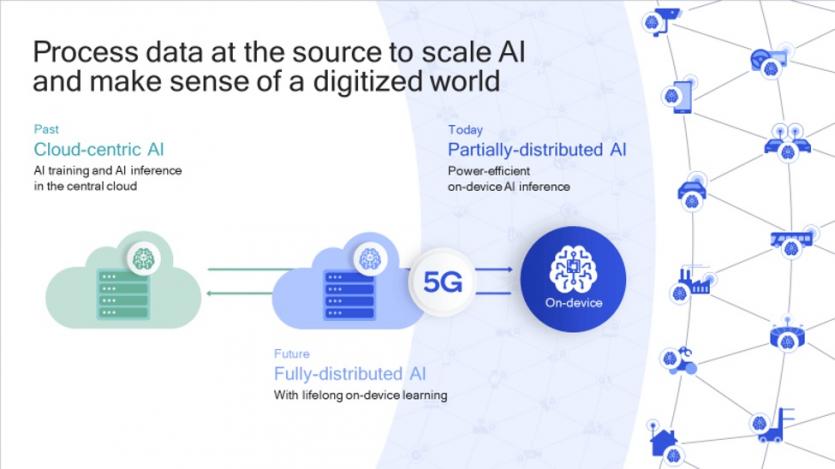
Figure 4
The edge or center cloud sends a global AI model to the devices in the first step. Then, each device uses the data it collects about the user to teach the model on the device (Figure 5). The large-scale training process requires heavy computing, which is why the cloud is used today.
Now, if we break the considerable training into smaller training sets, we will be able to manage the workload. In addition, the capabilities of the intelligent model on the device are tremendously improved, and the appliance can make better use of intelligent algorithms and software.
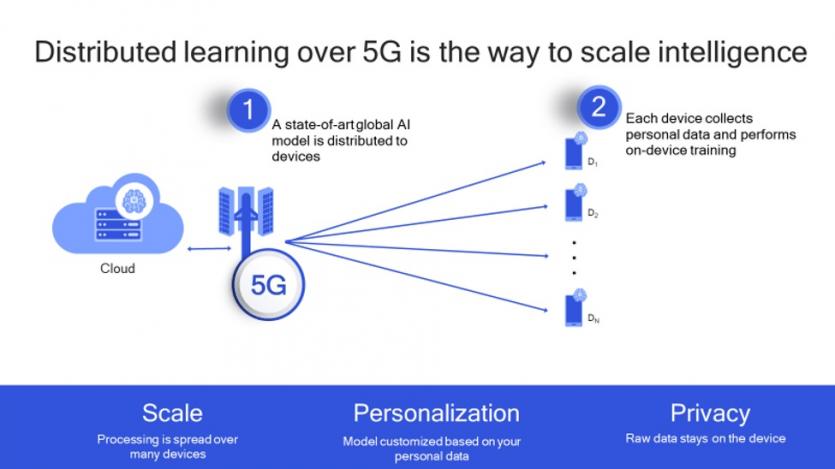
Figure 5
Training on consumer devices has the following three essential benefits that increase the use of artificial intelligence:
- Scale: Powerful computing power can be achieved by distributing general processing processes over millions of devices. It requires a high-speed communication channel that transmits or receives data quickly.
- Personalization: A fully customizable innovative model is obtained when the user’s data is on their device for training.
- Privacy: Raw data will never go to the cloud from the user’s device. When this data is used to teach the model installed on a device, privacy is maintained, and the information is not shared with third parties or companies.
How can we use a global AI model on all devices?
Without sending raw data to the cloud, the question arises as to how we can improve the performance of a global AI model while maintaining individual privacy. Qualcomm engineers were able to overcome this problem by adding noise to the parameters of the artificial intelligence model. The following steps in this field include improving the performance of intelligent models that are to be deployed on various devices.
They obscure the data, compress some metrics, encode the compressed model, and finally send the updated model to the cloud. Next, the cloud updates the AI model based on the inputs it receives from all devices and then sends the optimized AI model to the devices (Figure 6).
This loop is repeated over and over to model performance improve artificial intelligence. Of course, this process will not simply be what is said in this summary. Qualcomm is conducting extensive research into the latest 5G advances in artificial intelligence.
In addition, Qualcomm seeks to discover the potential benefits through which the idea of an innovative wireless edge can achieve.
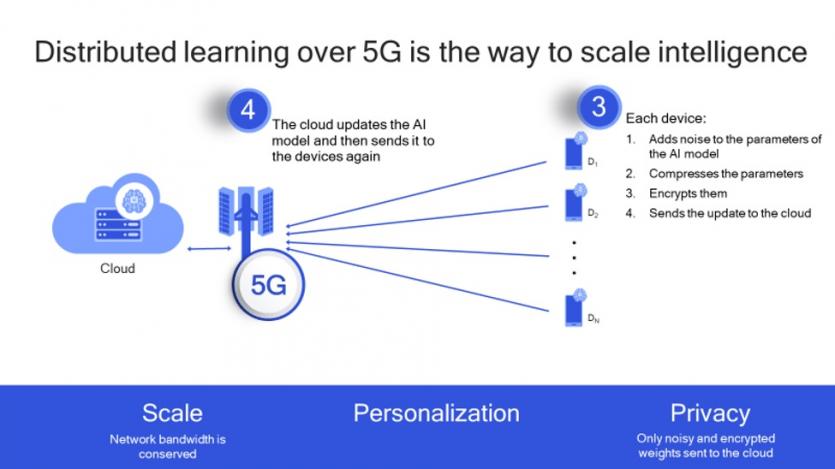
Figure 6
What role will artificial intelligence play in future mobile networks?
With the widespread availability of 5G, mobile communication service providers face new challenges; Integrating artificial intelligence techniques and patterns into 5G networks is one of the best ways to overcome problems and complexities. Ericsson has surveyed its business partners on how to use artificial intelligence in 5G networks, and the answers to some of them are interesting in their way.
Estimates show that 53% of service providers will have used artificial intelligence capabilities on 5G sites by 2020. However, some plan to use artificial intelligence to better manage 5G networks by 2025.
Reducing operating costs and ensuring a return on investment in the network are among the top priorities of 5G service providers. Some Ericsson partners believe that the highest return on investment is through artificial intelligence in network planning and design. In contrast, others plan to use artificial intelligence to manage the performance of 5G networks. Figure 7 shows the key areas most likely to receive a return on investment in artificial intelligence.
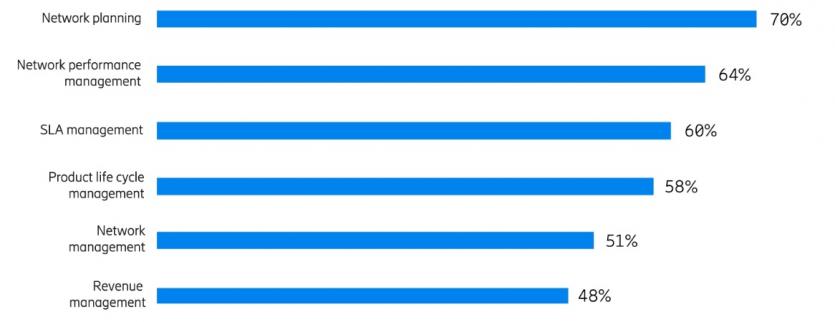
Figure 7
Mobile communication service providers have concluded that they need to develop current platforms to collect, structure, and analyze large volumes of data that AI can process. For this reason, companies that can use artificial intelligence solutions to overcome 5G challenges in the short term gain a significant competitive advantage over their competitors, which ensures their long-term profitability.











